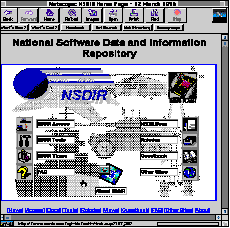






|

 

|

|
The National Software Data and Information Repository (NSDIR) is a repository of data and information about software projects. Although initially focused on the USAF projects, the NSDIR is challenged to obtain similar software metrics data from other sources beyond the USAF. Data from the USAF, other services, federal agencies and commercial industry will enable decision-makers to benchmark technologies used in software projects and observe national trends in software.
The NSDIR is an Air Force initiative originally sponsored by Mr. Lloyd Mosemann, formerly the Deputy Assistant Secretary for Communications, Computers and Logistics, Office of the Assistant Secretary of the Air Force for Acquisition. The NSDIR is managed by the Air Force Electronic Systems Center. Loral Defense Systems is the lead contractor on the NSDIR and is supported by Software Productivity Solutions, Inc. (SPS).
The NSDIR was begun through the Cooperstown Conferences. The NSDIR has collected high-level project profile data, mainly on USAF projects, and developed an Information Analysis Tool (IAT) for providing interactive access to the data. The National Software Data and Information Repository (NSDIR) User's Group Meeting, held in Melbourne, Florida, on 20-23 February 1996, reviewed the status and direction of the NSDIR. Attendees included users with a wide range of knowledge and experience with the NSDIR, from some who had contributed data and examined analysis results to others who had merely browsed the Web site.
David Card (SPS) began the meeting by presenting a one-day tutorial, "Practical Principles of Software Measurement." Lt. Col. Dan Romano (SAF/AQRE) began the morning of the second day by welcoming the attendees. The keynote speech, delivered by Mr. William James (HQ USAF/SCT), focused on the need to have something very simple to use in briefing upper management in the DoD and the need for a measure of user-satisfaction, as opposed to the technical infrastructure measures that the metrics community has usually concentrated on. He indicated a willingness to provide continual NSDIR support. Both Lt. Col. Romano and Mr. James mentioned the importance of transitioning the NSDIR from representing the Air Force or the DoD to an industry repository as well. They expect to soon have Army data to add to current Air Force data.
Mr. Scott Hissam (Loral) presented an overview of the NSDIR, including capabilities, current activities, a long term vision, and demonstrations of the IAT. Mr. Ray Dion closed the morning session by discussing a software measurement and improvement program at Raytheon based on the Software Engineering Institute (SEI) Capability Maturity Model (CMM).
The remainder of the meeting was consumed by working groups, including final reports of each group to the entire meeting. Working groups were organized around Data Entry/Access, Benchmarking/Baselining, Confidentiality/Security, Software Estimation and Process Improvement, and Participation/Sponsorship. The working groups suggested a need for more detailed metric data and some reorganization of the current tool interface. The MS Windows-based IAT is currently more advanced than the World Wide Web version in that the user can setup certain "filters" under MS Windows. Additional NSDIR products and services were suggested, including narrative information and reports, pointers to other databases, and training. A resident affiliates program was broached. The Participation/Sponsorship group requested the development of a business model, marketing, advertising, and the publishing of papers.


|

 

|

|